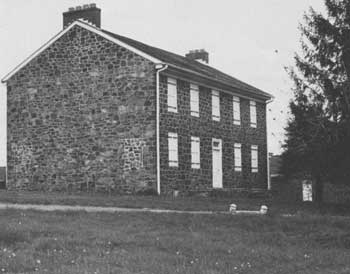







Survey of
Historic Sites and Buildings
 |
LOMBARDY HALL Delaware |
|
| ||
Gunning Bedford, Jr., resided periodically at Lombardy Hall, a 250-acre estate, from 1793 until his death there in 1812. He frequently entertained guests at the plain Georgian residence, and operated a model farm on his holdings.
Lombardy Hall occupies part of what was once known as the Manor of the Rocklands, a 986-acre tract William Penn had granted in 1682 to Valentine Hollingsworth, who renamed it New Wark. In 1726 George Robinson, Hollingsworth's son-in-law, purchased 250 acres of this land and named it Pizgah (Pisgah). In 1785 Bedford acquired the estate from Charles Robinson, a great-grandson of the original grantee; and 8 years later, when he obtained clear title, redesignated it as Lombardy Hall. Upon his death, his widow, Jane, continued to live there until 1817 and rented it out until her death in 1831, after which it stayed in the family's hands for many years.
By 1750 George Robinson had constructed a small farmhouse of gray-black Brandywine gabbro and fieldstone that now constitutes the north section of the present residence. The two-story dwelling contained two rooms on each floor. The main entrance, hall, and stairway were apparently on the south side of the building. Windows were recessed at right angles in the 18-inch thick walls.
Bedford attached a new wing to the south wall of the structure. This created a symmetrical five-bay facade, whose center front entrance faced west. He also rebuilt the attic and roof of the earlier, or Robinson, section to conform with his gable-roofed, 2-1/2-story addition. Although the gabbro of the older structure was skillfully matched in the facade of the Bedford addition, a slim vertical line of mortar on the facade and east wall still outlines the location of the original south wall. The gabbro was extended a short distance around the corner on the new south wall, and then apparently the building was completed in fieldstone. The windows in the newer portion were set in wide-angled, paneled recesses.
 |
| Lombardy Hall. (National Park Service (Post, 1973).) |
The residence, which has a simple Quaker-like dignity, is in fair condition after years of neglect. It is being restored. The immediate grounds, now consisting of little more than an acre, adjoin a shopping center on the south and Lombardy Cemetery, with which Lombardy Hall shares a driveway entrance, on the north.
A rectangular transom accents the paneled front door, and the east wall features a frontispiece entrance. The wood-shingled roof, which replaced one of slate, has an interior chimney near each end. A dentiled cornice runs the length of the building. Shutters flank the windows of the facade and east wall. Two former windows have been walled in. This left the north wail blind, as originally constructed.
A large portico and 1-1/2-story stone wing with separate entrance were added to the house about 1820, but were removed by the end of the century. About 1920 a one-story, flat-roofed, two-stall garage was attached to the south side of the house. It was constructed of stone recovered from a barn and carriage house that had once stood behind the residence. Except for this modern addition, the exterior of the building for the most part remains unaltered.
The long center hall, which extends from the front entrance to the rear door, contains a two-well staircase at the rear. The ballroom lies to the south, and two smaller rooms, to the north. The second floor contains four bedrooms. A bathroom, installed in what was once the west end of the hail, constitutes the only significant interior modification.
The ballroom features an Adam-style mantel, delicately carved and shelved at each end. Corner fireplaces in the pair of bedrooms over the ballroom meet at the south wall, back to back, at the partition. Original chair railings, cornice moldings, stairs, banisters, and much of the paneling remain in good condition.
In 1967 the Granite Masonic Lodge, recognizing Bedford's service as first Grand Master of the Grand Lodge of Delaware, purchased the property. The next year, the group formed the Lombardy Hall Foundation, Inc. It is now, in cooperation with the Delaware Archeological Society and a private architectural firm, restoring the building and grounds to their appearance during Bedford's residency. When the project is completed, the structure will serve as the lodge's meeting hail and also as a library and museum. The house is presently open to the public on a restricted basis.
 |
 |
http://www.cr.nps.gov/history/online_books/constitution/site44.htm
Last Updated: 29-Jul-2004